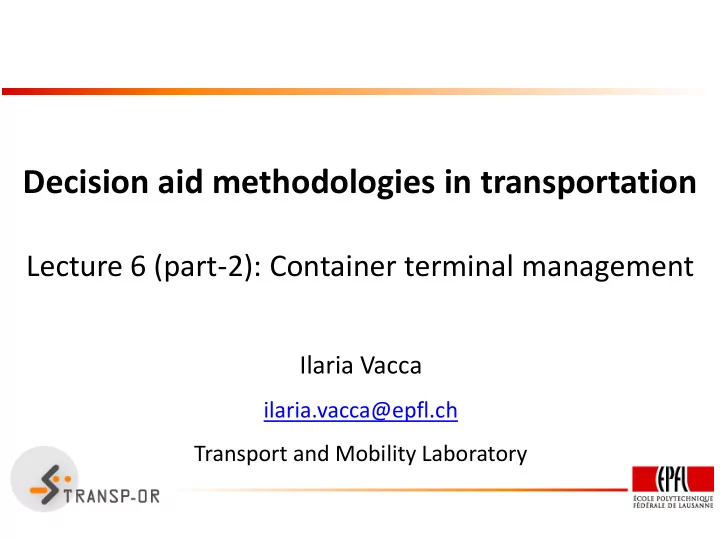

Decision aid methodologies in transportation Lecture 6 (part-2): Container terminal management Ilaria Vacca ilaria.vacca@epfl.ch Transport and Mobility Laboratory
Outline Introduction to maritime transport Overview container terminals Operations and optimization problems The Berth Allocation Problem The Quay Crane Scheduling Problem Conclusion
Shipping and Maritime Trasport • Major transportation mode of international trade • Three modes of operations: • Industrial shipping: the cargo owner also owns the ship • Tramp shipping: operates on demand to transfer cargo • Liner shipping: operates on a published schedule and a fixed port rotation May 24, 2011 Container terminal management 3
Shipping and Maritime Transport Optimization problems in Maritime Shipping • design of optimal fleets in size and mix • ship routing (sequence of ports) • ship scheduling (temporal aspects) • fleet deployment (assignment of vessels to routes) May 24, 2011 Container terminal management 4
Shipping and Maritime Trasport • Ships carry different type of freight: • Solid bulk • Liquid bulk • Containers • Containerized trade accounts for 25% of total dry cargo (UNCTAD, 2008) • Annual growth rate: 9.5% for containers vs 5.3% for general cargo (between 2000 and 2008) May 24, 2011 Container terminal management 5
Container world trade 600 500 400 Million TEUs 300 200 100 0 1995 1996 1997 1998 1999 2000 2001 2002 2003 2004 2005 2006 2007 2008 May 24, 2011 Container terminal management 6
Top container terminals Million TEU Worldwide 1999 2007 2008 2009 1 Singapore (Singapore) 15.9 27.9 29.9 25.9 2 Shangai (China) 4.2 26.1 28.0 24.9 3 Hong Kong (China) 16.2 23.9 24.5 21.1 Europe 1 Rotterdam (Netherlands) 6.2 10.7 10.8 9.7 2 Antwerp (Belgium) 3.6 8.1 8.7 7.3 3 Hamburg (Germany) 3.8 9.9 9.7 7.0
Container terminals Quayside Gate Yard
Scheme of a container terminal May 24, 2011 Container terminal management 9
Scheme of a container terminal May 24, 2011 Container terminal management 10
The Quay Berthing positions or Berths
The Quay Ships or Vessels
The Quay Quay cranes (QC)
Quayside operations • Berth allocation • Assign vessels to berthing positions • Schedule incoming vessels • Quay crane assignment & scheduling • Assign quay cranes to moored vessels • Schedule their movements May 24, 2011 Container terminal management 14
The Yard May 24, 2011 Container terminal management 15
The Yard Yard blocks May 24, 2011 Container terminal management 16
The Yard Yard cranes May 24, 2011 Container terminal management 17
The Yard May 24, 2011 Container terminal management 18
Yard operations • Yard/block allocation • Assign a block in the yard to groups of unloaded containers • Storage space allocation • Assing a slot within the block to every container • Yard crane allocation and scheduling • Assign yard cranes to yard blocks • Schedule their movements and their workload May 24, 2011 Container terminal management 19
Transfers and Gate operations • Transfers • From quay to yard / from yard to gate • Fleet management / scheduling of trucks and AGV • Gate operations • Retrieve stored containers • Loading of trucks and trains
Optimization problems & Solution process 1. Problem definition • Data • Objective • Constraints 2. Mathematical model • Equations 3. Solution algorithm • MIP solver • Heuristics / Exact approaches 4. Results
The Berth Allocation Problem Given : • A set of incoming vessels • A set of discrete berths / A continuos quay • A time horizon • Time windows on the vessels ’ arrival time • Vessels ’ length • Vessels ’ expected handling time
The Berth Allocation Problem We aim to : • Assign ships to berths • Schedule the ships in every berth Such that : • A cost function is minimized • All vessels arrive within their time window • No overlap in space and time
A berth allocation plan
The Tactical Berth Allocation Problem
The mathematical model Decision variables: • x(i,j,k) : 1 if vessel j is assigned to berth k right after vessel i • T(i) : arrival time of vessel i Objective function: • minimize cost / maximize profit Constraints: • do not overlap in space and time • arrival within the time window
The mathematical model
The mathematical model • General purpose solvers (Cplex, Gurobi, etc.) • Fail because the problem is too complex • Only small instances are solved • It takes ages to provide a solution for real size instances
The solution algorithms • Heuristic algorithm • Provide feasible solution, not the optimal one • Use simple rules and is fast • Exact algorithm • Designed for this specific problem • Use sophisticated techniques • Provide optimal solutions
Computational results May 24, 2011 Container terminal management 30
The Quay Crane Scheduling Problem Given • A set of moored vessels • A set of holds for every vessel • A set of quay cranes • The processing time of holds by a quay crane May 24, 2011 Container terminal management 31
The Quay Crane Scheduling Problem We aim to • Assign quay cranes to holds • Schedule the quay cranes in time Such that • The latest completion time is minimized • No overlap between cranes occurs May 24, 2011 Container terminal management 32
The Quay Crane Scheduling Problem May 24, 2011 Container terminal management 33
The mathematical model Decision variables • X(h,k) : 1 if hold h is handled by crane k • Y(h,h ’): 1 if hold h finishes before h’ starts • C(h) : completion time of hold h Constraints: • Every hold must be performed by one crane • Precedence constraints • Interference constraints May 24, 2011 Container terminal management 34
The mathematical model May 24, 2011 Container terminal management 35
Results May 24, 2011 Container terminal management 36
Summary • Many decision problems in container terminals • Modeled as optimization problems (MIPs) • Optimization is helpful in Reducing costs Improve productivity and efficiency Reduce delays / Speed up operations May 24, 2011 Container terminal management 37
Recommend
More recommend